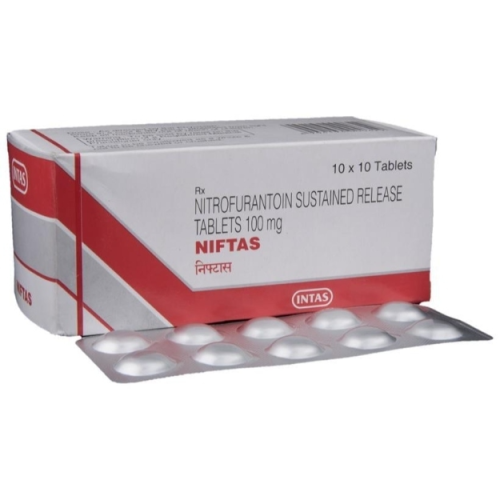Manufacturer: INTAS
Pharmaceutical name: Nitrofurantoin Monohydrate
Pack: 10 pills (100 mg)
Nitrofurantoin can act as either a bacteriostatic or bactericidal agent, depending on its concentration and the susceptibility of the infecting organism. It is effective against certain gram-positive bacteria, including S. aureus, S. epidermidis, S. saprophyticus, Enterococcus faecalis, S. agalactiae, group D streptococci, viridians streptococci, and Corynebacterium. Its efficacy against gram-negative bacteria encompasses E. coli, Enterobacter, Neisseria, Salmonella, and Shigella. Nitrofurantoin may serve as an alternative to trimethoprim/sulfamethoxazole for treating urinary tract infections, although it may be less effective in eliminating vaginal bacteria. Additionally, it can be used by females as a preventive measure against recurrent cystitis associated with sexual intercourse. This drug is remarkably resistant to the development of bacterial resistance, which is believed to stem from its multiple mechanisms of action.
Niftas may also be used as an alternative for treating urinary tract infections. It can be utilized by females peri-coitally for preventive care against recurrent cystitis related to sexual activity.
Niftas displays bacteriostatic or bactericidal properties by interfering with the synthesis of DNA, RNA, proteins, and cell walls.
The activation of Niftas occurs through bacterial flavoproteins (nitrofuran reductase), converting it into reactive intermediates that are believed to damage ribosomal proteins and other macromolecules, particularly DNA, leading to the inhibition of DNA, RNA, protein, and cell wall synthesis. Ultimately, this results in the suppression of bacterial growth or cell death.
Niftas is effectively absorbed in the gastrointestinal tract, primarily in the small intestine, with absorption increased by food or slower gastric emptying due to enhanced dissolution rates of the medication.
Acute toxicity may result in vomiting, while side effects may include nausea and urine discoloration. Rarely, hepatotoxicity and hypersensitivity reactions have been reported. There is a risk of hemolytic anemia in individuals with G6PD deficiency. Prolonged therapy or low creatinine clearance may lead to ascending polyneuropathy.

